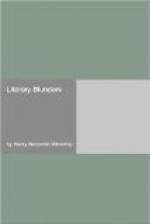Fortunately for the fun of the thing, the word occurred
in an article on Indian Missions, by Sydney Smith.
We read, ``The Hindoos have some very strange customs,
which it would be desirable to abolish. Some
swing on hooks, some run knises through their
hands, and widows burn themselves to death.’’
The reviewer was attacked for his statement by Mr.
John Styles, and he replied in an article on Methodism
printed in the Edinburgh in the following year.
Sydney Smith wrote: ``Mr. Styles is peculiarly
severe upon us for not being more shocked at their
piercing their limbs with knises . . . it is
for us to explain the plan and nature of this terrible
and unknown piece of mechanism. A knise,
then, is neither more nor less than a false print
in the Edinburgh Review for a knife; and from
this blunder of the printer has Mr. Styles manufactured
this Daedalean instrument of torture called
a knise.’’ A similar instance
occurs in a misprint of a passage p 5of one
of Scott’s novels, but here there is the further
amusing circumstance that the etymology of the false
word was settled to the satisfaction of some of the
readers. In the majority of editions of The
Monastery, chapter x., we read: ``Hardened
wretch (said Father Eustace), art thou but this instant
delivered from death, and dost thou so soon morse
thoughts of slaughter?’’ This word is
nothing but a misprint of nurse; but in Notes
and Queries two independent correspondents accounted
for the word morse etymologically. One
explained it as ``to prime,’’ as when
one primes a musket, from O. Fr. amorce, powder
for the touchhole (Cotgrave), and the other by ``to
bite’’ (Lat. mordere), hence ``to
indulge in biting, stinging or gnawing thoughts of
slaughter.’’ The latter writes:
``That the word as a misprint should have been printed
and read by millions for fifty years without being
challenged and altered exceeds the bounds of probability.’’
Yet when the original MS. of Sir Walter Scott was
consulted, it was found that the word was there plainly
written nurse.
The Saxon letter for th (?p) has long p 6been a sore puzzle to the uninitiated, and it came to be represented by the letter y. Most of those who think they are writing in a specially archaic manner when they spell ``ye’’ for ``the’’ are ignorant of this, and pronounce the article as if it were the pronoun. Dr. Skeat quotes a curious instance of the misreading of the thorn (?p) as p, by which a strange ghost word is evolved. Whitaker, in his edition of Piers Plowman, reads that Christ ``_polede_ for man,’’ which should be tholede, from tholien, to suffer, as there is no such verb as polien.




